ISSN
2307–3489 (Print), ІSSN
2307–6666
(Online)
Наука
та прогрес транспорту. Вісник
Дніпропетровського
національного університету залізничного
транспорту, 2018, № 6 (78)
Експлуатація
та ремонт засобів транспорту
UDC
656.22.05
H.
I. NESTERENKO1,
P. V.
BECH2,
M. I.
MUZYKIN3*,
S. I.
AVRAMENKO4
1Dep.
«Management of Operational Work», Dnipropetrovsk National
University of Railway Transport named after
Academician V. Lazaryan,
Lazaryan St., 2, Dnipro, Ukraine, 49010,
tel. +38 (056) 373 15 70,
e-mail mihailmuzykin@gmail.com,
ORCID 0000-0003-1629-0201
2Dep.
«Management of Operational Work», Dnipropetrovsk National
University of Railway Transport named after
Academician V. Lazaryan,
Lazaryan St., 2, Dnipro, Ukraine, 49010,
tel. +38 (095)
225 38 64,
e-mail Bekhpit@gmail.com,
ORCID 0000-0002-1782-9224
3*Dep.
«Life Activity Safety», Dnipropetrovsk
National University
of Railway Transport
named after Academician V. Lazaryan,
Lazaryan St., 2, Dnipro,
Ukraine, 49010, tel. +38 (095) 251 53 14,
e-mail
mihailmuzykin@gmail.com,
ORCID 0000-0003-2938-7061
4Dep.
«Life Activity Safety», Dnipropetrovsk
National University
of Railway Transport
named after Academician V. Lazaryan,
Lazaryan St., 2, Dnipro,
Ukraine, 49010, tel. +38 (066) 082
88 27,
e-mail
fufei8791@gmail.com, ORCID
0000-0002-5832-6949
IMPROVEMENT
OF SUPERVISORY CONTROL
OF TRAIN MOVEMENT
BY MEANS OF INTRODUCTION
OF OPERATIONAL ZONES
Purpose. The
work is aimed to investigate the feasibility of transferring
automatic control to low-density stations of the sections (according
to the principle of supervisory control of trainline) to the
operators at principal stations. Methodology. The article
analyzes the work of heavy traffic sections of the Ukrainian Railways
JSC. It was found out that the information workload of dispatchers
who control the train movement at the sections of the main course,
constantly exceeds the permissible level. The possibility of using
the technology of supervisory control of train movement by the
introduction of operational zones has been investigated. Findings.
The authors found out that the capacity of receiving and
departure tracks at the stations of the sections is extremely
limited. The occupancy of run-around tracks by the out-of-work trains
hinders any regulatory measures at the sections. Trains pass one
after another without giving priority, that is, they pass through the
section in the order in which they entered it. Due to the limited
number of tracks at the pre-section intermediate station, freight
trains are placed for run-around by the passenger ones at the distant
approaches. This leads to a loss of service speed and reduces the
level of utilization of the sections` working capacity. The
introduction of operational zones will significantly reduce
information flows and facilitate the work of the train dispatchers,
create the necessary conditions for creative decision-making on the
inter-sectional regulation, and will contribute to increase in the
service speed of trains. Originality. The article developed a
new technology to improve the management of train sections by
dividing them into operational zones. In each zone, consisting of two
or three run-arounds, the duty officer of the principal station,
performing in this case the functions of the train dispatcher, can
control the train movement. Practical value. It has been
proposed to put trains from technical stations that idle due to
uneven movement, especially the trains from the terminal stations
(division points) of the locomotive circulation sections, to reserve
routes of the pre-section intermediate stations. Laying the reserve
tracks and their maintenance, taking into account the periodicity of
use and reduced permissible speed, can be allowed according to less
tight standards for the construction of the roadbed, ballast section,
sleeper density, taking into account the use of switches and
decommissioned tracks.
Key words:
train schedule; dispatch control; freight trains; train delay time;
principal station
Introduction
In our country railway transport
has a significant influence not only on improving the economic and
financial results, but also on the results of other sectors of the
economy. Improvement of the system of interaction between railways
and production is carried out in the direction of increasing the
quality of transportation process with the expansion of the range of
services, which contributes to the growth of transportation volumes.
Therefore, in the conditions of competition, the total volumes of
railway transportations depend primarily on the production volumes.
In addition, they are also influenced by the quality of transport
services, which in modern conditions is of particular relevance.
Thus, improving the quality of transport services with increase in
the list of services significantly expands the customers` circle,
contributes to the growth of railways revenues, strengthens the
railway transport`s positions in the market and positively
influences the overall result of economic transformations.
According to the experience of
improving the organization of railway operation in different
countries, in modern realities, they aim to fully satisfy the
requirements of customers regarding the terms of goods delivery due
to the high reliability train movement schedule, which is the basis
of the transportation process technology [2]. Under conditions of
the existence of a multi-level management system of transportations,
the separation of management at the level of the transport corridors
network becomes necessary. This will make it possible to coordinate
the technological and infrastructural capabilities of all units of
PJSC "Ukrainian Railways" within the defined railway line
in order to form a rational system for the promotion of specialized
car traffic volumes [10].
Railway transport directs its
efforts to strict adherence to the traffic schedule and the order of
use of rolling stock in accordance with the plan for trains
formation, technical regulation. On the other hand, large
financial-industrial groups, which make up the majority of cargo
owners, began to minimize their expenses with the aim of maximizing
income, primarily transferring the cargo storage costs to the
state-owned company PJSC "Ukrainian Railways" (PJSC "UZ")
by using public cars as "wheeled warehouse". The
financial-industrial groups began to include railway transport in
the management of the sales process (and this is nothing more than
the management of freight traffic volumes) and influence its
technology [9]. So, whereas previously the department of traffic
management exclusively dealt with the issues of the train formation
plan, in recent years – with the issues of harmonization of the
routes and conditions of goods transportation in individual
companies. Due to the sharp decline in production and
transportations, the need to compete for custom in the new economic
conditions, railway transport has increasingly become to take into
account the custom`s requirements and adapt to them.
The article [11] emphasizes that
competition at transport is a struggle for cargo owners and
passengers, obtaining the most beneficial effect on the basis of the
use of modern, more efficient technologies, improving the quality of
transportations, their reliability and speed of movement of goods
and passengers. The expediency of the use of modern dispatch train
movement control systems is confirmed by the results of the study,
set forth in the article [3]. Also, this study focuses on the fact
that the task of constructing and improving the transport
technologies and traffic management systems are relevant.
The article [1] studies the
influence of various factors on the implementation of the technology
of car traffic volume passage under conditions of rigid route
schedules based on the criteria for rationalization of fuel and
lubricant costs, timely goods` delivery, etc. in order to identify
competitive variants of the organization of train traffic volumes.
Establishing priorities for the provision of services at the section
and the use of the balance methodology makes it possible to
rationalize the work of a given railway station or direction [8].
The authors` thoughts on the network effects that arise during the
train operation are quite interesting. The authors emphasize that
one section cannot be considered as a completely independent part of
the entire railway network.
The work [17]
uses integration of software products of micro and macro levels of
simulation was used, which allows estimating the influence of the
primary delay in train movement on the distribution of general delay
at the section and improving the research accuracy. The analysis of
primary delays and the use of carrying capacity shows that there is
a high degree of dependence between periods with a high frequency of
delays and bottlenecks in carrying capacity [16]. In the article
[12], the authors argue that the train movement schedule is stable
if any delay in the train movement of can be compensated by time
reserves without the need to activate the work of train dispatcher.
The paper [6] introduces the
term "operational reliability" in order to assess the
stability of the train schedule. The team of authors in the paper
[14] proposed to assess the adherence stability of the train
movement schedule, depending on the complexity of operations: the
fewer conflicts in the schedule, the higher the stability of the
movement schedule. The manual [5] presents the methodology of
determining the time reserve for solving conflict situations that
occur during the laying of passenger and freight trains` movement on
the schedule.
The works
[13, 15, 18–19]
solve the task of transportations dispatching at the level of
management not only to control the train schedule, but also for the
purpose of its operational correction. In their research, scientists
also attempt to create a standard schedule of train movement on the
tactical level of planning.
In the study [4], the authors
propose a method for ranking trains and route schedules according to
priority. They attempted to develop an automated system "Predicted
train schedule" at the Belarusian railway, with the help of
which it is possible to predict the schedule for 3 hours. Thus, the
authors resolved the task of increasing the operation efficiency of
a section by automating the supervisory control of the train work.
Research in this direction is quite promising.
In the article [7], the authors
developed a method of algorithmic description of the process of
making managerial decisions by the train dispatcher in relation to
the determining the cross-over stations taking into account the
priority of trains. In the future, this algorithm can become the
basis for creating a decision support system that will be integrated
into the automated work station of the train dispatcher (AWS TD).
In today's realities, train
dispatchers (DNCs) operate under heavy load conditions. From time to
time, this affects the quality of their decisions during the
operational management of train work at the sections. In view of
this, it is expedient to develop the measures that will allow
transferring the part of the functions of train management to other
participants in the transport process; in particular, it may be duty
officers at the principal stations.
Purpose
For further development of the
technical means of Ukrainian railway transport it is necessary to
have several variants of the rational technology of the main
production process – the organization of the train movement.
The purpose of the article is to
investigate the expediency of the automatic control transfer of
low-density stations of a section (according to the principle of
centralized traffic control) top the duty officers at the principal
stations.
Methodology
Already, in some areas of the
railway network, there is a tension in the work due to a significant
reduction of available capacity reserves. The work carried out at
the railways in order to maximize the delineation of lines for
freight and passenger traffic, will significantly increase the
operating voltage on the lines where the concentration of freight
and passenger traffic takes place. The growth of transportation
volumes in the future will further complicate the transportation on
these lines, will worsen the operation of railways, disrupt the
rhythm and quality of transport services. Taking into account these
circumstances, the development of railway capacity under new
conditions should be addressed as an increase in the line power. To
do this one should have adequate financial resources, as well as the
search for new technologies and reserves at each element of the
railway system.
The state of operational
activity of railways indicates a violation of the complexity of
approach to the capacity development of the lines, stations, use of
rolling stock, etc. Today, the construction of train schedules is
carried out as follows. At the first stage, according to the
established directive documents and taking into account the set
priorities and constraints, the passenger and freight lines are
laid.
At the second stage (if it
exists), it is attempted to optimize the modes of train movement in
certain areas and routes to save energy resources, speed of delivery
of passengers and goods. At the same time, these goals, as a rule,
conflict with each other.
As a result, the railway
receives a plan that is far from ideal, both in terms of costs and
in terms of the passenger service and operators of freight
commercial transportations.
We propose a solution to these
problems, which includes:
– application of complex
approach to the construction of the schedule of passenger and
freight trains;
– accounting of
resource-saving modes at the stage of construction of schedules of
passenger (first of all, as a type of traffic with fixed schedules
and less energy-consuming) and freight trains;
– accounting of electricity
billing to optimize traction costs.
Findings
Train sections play an important
role in the transportation process. Suffice it to say that 25% of
the general time of car turnaround accounts for movement at the
sections.
Reduction of the lengths of
block-sections makes it possible to reduce the spacing of trains. At
some runs one can lay third and fourth main tracks.
In connection with the
non-synchronization of train movement, the minimum calculation
interval cannot be realized both from departure and from the arrival
of trains at the section's final station. In this case, the
calculated value of the carrying capacity is not achieved and the
average speed of the train traffic flow sharply declines.
The information workload of the
dispatchers, who control the train movement at the sections of the
main course, constantly exceeds the permissible level. Under these
conditions dispatcher apparatus often manages only to fix the train
situation. As a result, there are miscalculations in the passage of
trains at a section, in the choice of the order of their entering to
the junction, which ultimately leads to an even greater decrease in
the service speed.
The number of trains that can be
simultaneously in motion and at the same time move with the speed
set for this section is strictly limited. Accumulation of trains at
the sections, which exceeds a certain maximum value reduces the
speed of their movement. But in practice, nobody sets this maximum
permissible value and nobody is guided by it, which sometimes leads
to unacceptable oversaturation of sections by trains over the
established limits.
If the excess of trains is
insignificant and the technical stations and stations, capable to
cope with the increased size of movement are in front, then,
certainly, one should force the transfer of the train traffic
volume. If there is no such opportunity during this period, it is
necessary to restrict the movement of trains at such a section. To
shorten the number of trains, which are simultaneously in motion on
lines, to the established limit in exceptional cases can be due to
the temporary withdrawal of compositions at intermediate stations of
the district.
In exceptional cases it is
possible to shorten the number of trains, which are simultaneously
moving on lines, to the established limit due to the temporary
leaving of trains at intermediate stations of the section.
Stable, reliable operation of
intermediate stations for the acceptance of trains can be provided
in the presence of free main and one receiving-and-departure track
(duplicate element). In case of a failure (train stopping at the
station for any reason), it is always possible to let the next
trains to pass from this reserve track.
The maximum number of trains
left at the station should not exceed the total number of available
tracks, minus one track for each direction at each intermediate
station. In this case, one can use sidings, branches of enterprises
with seasonal work.
Fig. 1 shows
a fragment of the graph of traffic delay. At the limited number of
(only one) run-around tracks at the pre-section and other
intermediate stations due to the delay of not accepting the first
train going in a pack, the following trains are placed for
run-around at the previous intermediate stations. At this, even in
the case of favorable acceptance of trains from the section, in the
future there is a loss of carrying capacity
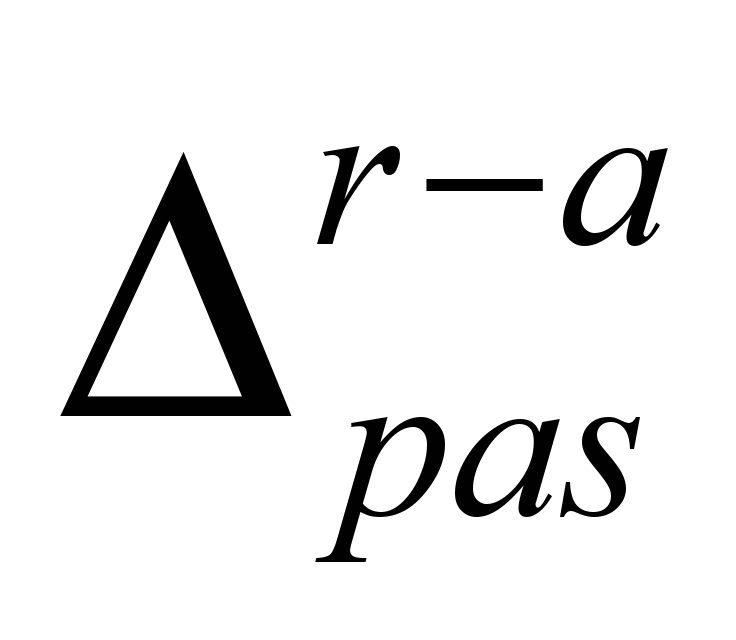 ,
caused by nonidentity of the runs and the difference in the time of
passage of the freight and passenger trains.
,
caused by nonidentity of the runs and the difference in the time of
passage of the freight and passenger trains.
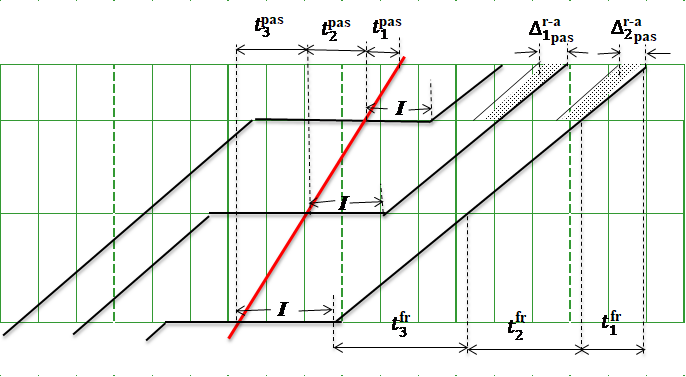
Fig.
1. Delay because of non-acceptance of the first train
Time losses
not used for train movement will equal to:
 ,
,
or
 , (1)
, (1)
where
 – is the time of freight train movement
on the first run (
– is the time of freight train movement
on the first run ( –
on the second, etc.);
–
on the second, etc.);
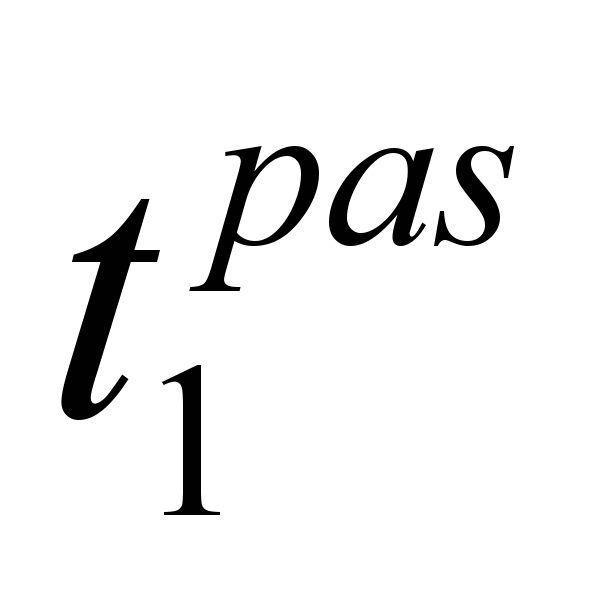 – is the
time of passenger train movement on the first run (
– is the
time of passenger train movement on the first run (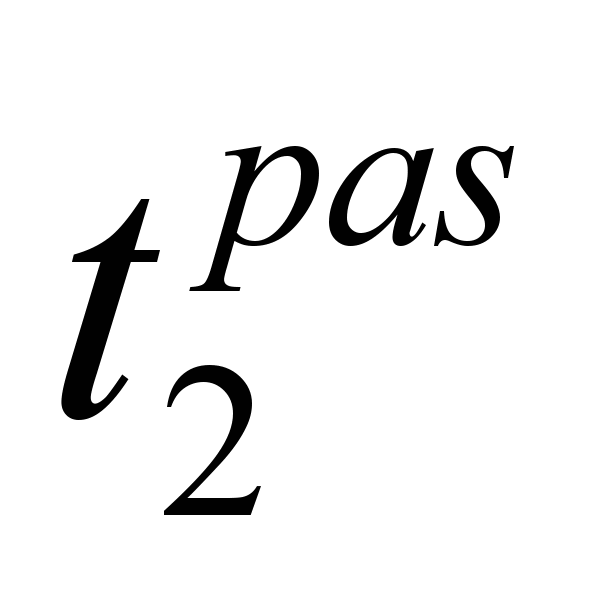 –
on the second, etc.);
–
on the second, etc.);
 – is the succession time.
– is the succession time.
Accordingly, time losses during
the passage of freight train from the third station will equal:
 . (2)
. (2)
The negative value of the
results obtained by formulas (1) and (2) indicates that there will
be no time losses and, therefore, carrying capacity.
As a rule, the last runs before
the section stations has less time of movement than other runs at
the section. It should be pursued further, because most often
complications in train movement arise because of their
non-acceptance by technical stations.
Fig. 2 shows that if there is a
required tracks reserve at the intermediate pre-section station,
trains freely pass to it. After passage of passenger train under
favorable conditions of its acceptance by station, the run is used
without losses of carrying capacity. The general time of train delay
is reduced per value of the total value of losses associated with
the run-arounds of freight trains by passenger ones.
In practice, a situation shown
in Fig. 3 often arises. Due to the non-acceptance by the section
station, freight trains are already placed for the run-around by a
passenger train, and it is possible to receive a freight train from
the section before a passenger one.
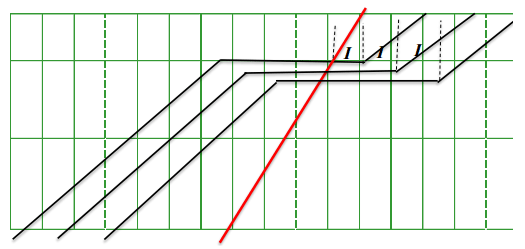
Fig.
2. Availability of the required reserve of tracks
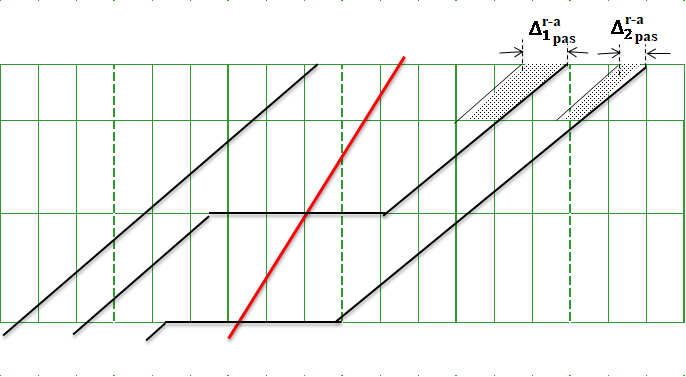
Fig. 3. Possibility
of acceptance of a freight train before a passenger one
In this case,
as shown in Fig. 3, after passage of a passenger train at the
pre-junction station, there are no available trains and, even in
case of favorable acceptance, its carrying capacity is not used. The
availability of reserve receiving-and-departure
tracks at pre-section intermediate
stations will create the necessary "support" for trains.
An analysis
of the work of freight-loaded sections also indicates the expediency
to equip the run-arounds before the technical stations by
either-direction automatic block system. In practice, there is often
a need to pass a passenger or other urgent train, but the right
run-around track is occupied. Passing along the wrong track takes a
lot of time for execution of train documentation. Often, there are
no access tracks required
for implementation of this regulatory measure at both intermediate
and section stations. In this connection, one should foresee double
dispatching access tracks on
both sides of the pre-section intermediate stations, as well as the
floating specialization of the receiving-and-departure tracks. Such
rearrangement of the necks of pre-section intermediate stations
should be carried out now, without waiting for a comprehensive
solution of the issues of improving the train sections reliability.
In future, the automatic control
of the low-density stations of the section can be transferred to the
principal stations (according to the principle of dispatching
centralization). This will make it possible to quickly cover the
costs of modernization due to the payroll budget economy, as well as
to stimulate the work of the train dispatchers, duty officers at the
principal stations of the operational zone.
The organization of the
operational zone for controlling the train movement on the ground
significantly reduces the information flows and facilitates the work
of the section`s train dispatchers, will create the necessary
conditions for creative decision-making for inter-sectional
regulation, will contribute to increasing service speed of train
movement.
The principle diagram of the
transmission of the source information may look in the following
way. In addition to the section stations, two pre-section
intermediate stations located at the ends of the section and one or
two principal stations of the operational zone carry out the direct
negotiations with the train dispatcher of the section. The
allocation of the operational zone at the sections does not require
any capital investments, since the existing communication lines can
be used for data transmission.
The reduction of the number of
information sources upon the availability of modern communication of
the principal stations with the train dispatcher of the section also
creates better conditions for automation of the process of movement
graph plotting. With the allocation of the operational area on the
section, there is no need to reflect the trains passing through the
stations located inside them, except the cases where these stations
carry out run-arounds and other regulating measures. It will be
sufficient to note only the time when trains enter the operational
zone and leave it, as shown in Fig. 4.
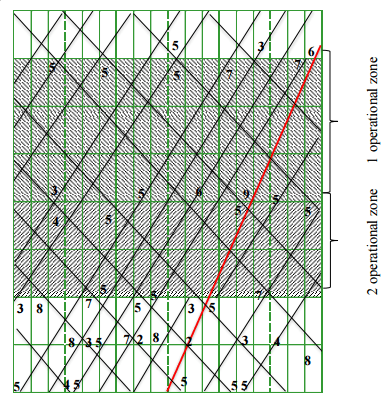
Fig.
4. Train passage through the operational zones
Maintenance
of the graph (displaying the lines of train passage through the
section) can be entrusted to operators. This will considerably
extend the range of people who are in urgent need of current
information about the course of train work at the sections (ДГП,
chiefs and senior dispatchers of the traffic departments, etc.).
The measures to improve the
reliability of train sections operation considered in the article
will accelerate the passage of car traffic volumes, improve the
conditions and increase the efficiency of the work of train
dispatchers.
The railways face a complex task
of tying up the forecast of electricity consumption with the
forecast of transportation volumes. Since the transportation process
is influenced by many factors, the Ukrainian railways may have
additional economic costs due to the overestimation or
understatement of the declared norms of electricity consumption.
The use of two-zone or
three-zone tariffs gives an effect not only with the steady and
uniform filling of the daily traffic schedule, but also at the
intensity of movement above the level determined by the specific
conditions. In this context, it is the various optimization measures
for regulating the train movement schedule that are relevant.
The
capacities of the receiving-departure tracks at the section stations
are extremely limited. The occupancy of the run-around tracks by
out-of-work trains prevents
carrying out any regulating measures inside the section. Trains
pass one after another without giving priority, that is, they pass
through the section in the order in which they entered it.
Frequently, due to the limited number of
tracks at the pre-section intermediate station, freight trains are
placed for run-around by the passenger ones at the distant
approaches. This leads to a loss of
service speed and reduces the level of utilization of the sections`
working capacity.
Originality and practical
value
To improve the management of
train stations, it is expedient to divide them into operational
zones. In each zone, consisting of two or three run-arounds, the
duty officer of the principal station, performing in this case the
functions of the train dispatcher, can control the train movement.
He determines the order of train passage within the zone, maintains
a schedule of performed traffic, informs the train dispatcher of the
section about the passage of trains through the operational zone
according to the established procedure, and receives from him
instructions on intra-zone regulation of train traffic.
For the development of
pre-section intermediate stations, it is necessary to provide
construction of one or two tracks for receiving multiple trains.
Uncoupling them at the stations` runs always leads to lower carrying
capacity. The presence of stations capable of performing separation
operations at the ends of the sections will facilitate the
application of already well-known at the railways method of
inter-sectional regulation of train movement. Thus, the construction
of reserve tracks at pre-section stations increases the possibility
of inter-sectional regulation of trains, provides a significant
economy of train-hours and increases the service speed.
One can also
place the trains from technical stations that are idle due to uneven
traffic, especially from the terminal stations (division points) of
locomotive circulation sections on the reserve tracks of pre-section
intermediate stations. The laying of such tracks and their
maintenance, taking into account the periodicity of use and reduced
permissible movement speed, for example, 10-15 km/h, can
be allowed according to less tight standards for the construction of
the roadbed, ballast section, sleeper density, taking into account
the use of switches and decommissioned tracks,
etc. If necessary, the parks of reserve tracks designed for hold of
the out-of-work trains that are placed for run-around, can be
located outside the station area, using a favorable terrain.
Conclusions
Increasing the capacity of all
railways transport enterprises of Ukraine in modern conditions and
in the future means, first of all, increasing the carrying and
transportation capacity of the most freight-loaded railway lines.
Taking into account the projected volumes of transportation at
railways, considerable work should be done on the modernization and
replacement of outdated equipment, to continue the electrification
of freight-loaded lines, to introduce modern ATC equipment, to
extend the station tracks at the courses of heavy, long and multiple
trains, to constantly improve the technology of cargo and passenger
transportation, etc. The phased implementation of such a complex and
wide-ranging program will enable PJSC "Ukrainian Railway"
to master the growing cargo turnover in the direction of transport
corridors and seaports and provide high-quality transport services
to cargo owners and population.
LIST OF REFERENCE LINKS
Бутько, Т.
В. Модель просування вагонопотоків в
умовах «жорстких» ниток графіку / Т.
В. Бутько, Т. О. Костиркіна // Зб. наук.
пр. Дон. ін-ту залізн. трансп. – Донецьк,
2010. – № 22. – С. 33–42.
Бутько,
Т. В. Удосконалення системи організації
роботи залізничного напрямку на основі
спеціалізації за призначенням ниток
графіка руху вантажних поїздів / Т. В.
Бутько, М. І. Музикін // Зб.
наук. пр. Укр. держ. ун-ту залізн. трансп.
– Харків, 2017. – Вип. 169 (додаток). – С.
153–155.
Долгополов,
П. В. Удосконалення перевізного процесу
на транспортному полігоні на основі
моделі диспетчерського управління /
П. В. Долгополов, В. П. Манзуля, А. О.
Роженко // Зб. наук. пр. Укр. держ. акад.
залізн. трансп. – Харків, 2014. – Вип.
145. – С. 11–17.
Ерофеев, А.
А. Автоматизация диспетчерского
управления поездной работой на
Белорусской железной дороге / А. А.
Ерофеев, Е. А. Ерофеева // Вісн. Дніпропетр.
нац. ун-ту залізн. трансп. ім. акад.
В.
Лазаряна. – Дніпропетровськ, 2012. –
Вип. 40. – С. 185–191.
Інструкція
зі складання графіка руху поїздів на
залізницях України : затв. наказом
Укрзалізниці від 05.04.2002 р. № 170-Ц. – Київ
: Транспорт України, 2003. – 146 с.
Каретников,
А. Д. График движения поездов / А. Д.
Каретников, Н. А. Воробьев. – Москва :
Транспорт, 1979. – 301 с.
Кокурин,
И. М. Алгоритмизация решений поездного
диспетчера по выбору станций скрещения
/И. М. Кокурин, А. Б. Васильев // Изв.
Петербург. ун-та путей сообщения. –
2015. – Вып. 2. – С. 47–55.
Прохорченко,
А. В. Проблеми розрахунку пропускної
спроможності залізничної інфраструктури
в умовах ринкових відносин / А. В.
Прохорченко // Інформ.-керуючі системи
на залізн. трансп. – 2014. – № 4. – С.
36–41.
Управління
вантажопотоками та вагонопотоками на
залізничному транспорті / П. В. Бех,
О.
В. Лашков, М. І. Музикін, Г. І. Нестеренко,
С. І. Авраменко // Вісн. Східноукр. нац.
ун-ту ім. В. Даля. – 2017. – № 3 (233). – С.
22–30.
Формування
логістичної технології просування
вантажопотоків за жорсткими нитками
графіка руху поїздів / Т. В. Бутько, Д.
В. Ломотько, А. В. Прохорченко, К. О.
Олійник // Зб. наук. пр. Укр. держ. акад.
залізн. трансп. – Харків, 2009. – Вип.
111. – С. 23–30.
Шляхи
підвищення конкурентоспроможності
залізничного транспорту в сучасних
умовах / П. В. Бех, Г. І. Нестеренко, С. І.
Музикіна, О. В. Лашков, М. І. Музикін //
Наука та прогрес транспорту.
–
2015. – № 5 (59). – С. 25–39.
doi: 10.15802/stp2015/55349
A
three-level framework for performance-based railway timetabling /
R. M. P. Goverde, N. Besinovic, A. Binder, V. Cacchiani, E.
Quaglietta, R. Roberti, P. Toth // Transportation Research. Part C:
Emerging Technologies. – 2016. – Vol. 67. – P. 62–83. doi:
10.1016/j.trc.2016.02.004
Caprara,
A. Modelling and solving the train timetabling problem / A.
Caprara, M. Fischetti, P. Toth // Operations Research. – 2002. –
Vol. 50. – Iss. 5. – P. 851–861. doi:
10.1287/opre.50.5.851.362
Delorme,
X. Stability evaluation of a railway timetable at station level /
X. Delorme, X. Gandibleux, J. Rodriguez // European Journal of
Operational Research. – 2009. – Vol. 195. – Iss. 3. –
P. 780–790. doi: 10.1016/j.ejor.2007.06.062
Hansen,
I. A. Railway Timetabling & Operations: Analysis, Modelling,
Optimization, Simulation, Performance Evaluation / I. A. Hansen, J.
Pachl. – Hamburg :
Eurailpress in DVV Media
Group, 2014. – 332 p.
Statistical
investigation on train primary delay based on real records:
evidence from Wuhan–Guangzhou HSR / W. Chao, L. Zhongcan, L.
Javad, F. Liping, H. Ping, J. Chaozhe // International Journal of
Rail Transportation. – 2017. – Vol. 5. – Іss.
3. – P. 170–189. doi: 10.1080/23248378.2017.1307144
Umiliacchi,
S. Improving railway operations through the integration of
macroscopic and microscopic modelling with optimisation : a thesis
submitted for the fulfilment of Doctor of Philosophy / Silvia
Umiliacchi ; The University of
Birmingham. – Birmingham, 2016. – 128 р.
Zhou,
X. Bicriteria train scheduling for high-speed passenger railroad
planning applications / X. Zhou,
M. Zhong // European Journal
of Operational Research. – 2005. – Vol. 167. – Iss. 3. –
P. 752–771. doi: 10.1016/j.ejor.2004.07.019
Zhou,
X. Single-track train timetabling with guaranteed optimality:
Branch-and-bound algorithms with enhanced lower bounds / X. Zhou,
M. Zhong // Transportation
Research Part B: Methodological. – 2007. – Vol. 41. – Iss. 3.
– P. 320–341. doi:
10.1016/j.trb.2006.05.003
Г. І.
НЕСТЕРЕНКО1, П. В. БЕХ2, М. І.
МУЗИКІН3*, С. І. АВРАМЕНКО4
1Каф.
«Управління експлуатаційною роботою»,
Дніпропетровський національний
університет залізничного транспорту
імені академіка В. Лазаряна,
вул.
Лазаряна, 2, Дніпро, Україна, 49010, тел.
+38 (056) 373 15 70,
ел. пошта mihailmuzykin@gmail.com,
ORCID 0000-0003-1629-0201
2Каф. «Управління
експлуатаційною роботою», Дніпропетровський
національний
університет залізничного
транспорту імені академіка В. Лазаряна,
вул. Лазаряна, 2, Дніпро, Україна, 49010,
тел. +38 (095) 225
38 64,
ел. пошта Bekhpit@gmail.com,
ORCID 0000-0002-1782-9224
3*Каф. «Безпека
життєдіяльності», Дніпропетровський
національний
університет залізничного
транспорту імені академіка В. Лазаряна,
вул. Лазаряна, 2, Дніпро, Україна, 49010,
тел. +38 (095) 251 53 14,
ел. пошта
mihailmuzykin@gmail.com,
ORCID 0000-0003-2938-7061
4Каф. «Безпека
життєдіяльності», Дніпропетровський
національний
університет залізничного
транспорту імені академіка В. Лазаряна,
вул. Лазаряна, 2, Дніпро, Україна, 49010,
тел. +38 (066) 082
88 27,
ел.
пошта fufei8791@gmail.com,
ORCID 0000-0002-5832-6949
Удосконалення
диспетчерського
регулювання руху
поїздів за
допомогою введення
оперативних зон
Мета.
У роботі необхідно
дослідити доцільність
передачі автоматичного керування
малодіяльними станціями дільниці (за
принципом диспетчерської централізації)
черговим по опорних станціях. Методика.
У статті проаналізована
робота вантажонапружених дільниць ПАТ
«Українська залізниця». Виявлено, що
інформаційна завантаженість диспетчерів,
що керують рухом поїздів на дільницях
головного ходу, повсякчас перевищує
допустимий рівень. Досліджено можливість
використання технології диспетчерського
регулювання руху поїздів за допомогою
введення оперативних зон. Результати.
Виявлено, що ємності
приймально-відправних колій на станціях
дільниці вкрай обмежені. Займання
обгінних колій «залишеними» поїздами
заважає проведенню будь-яких регулювальних
заходів усередині дільниці. Поїзди
слідують один за одним без надання
пріоритету, тобто слідують по дільниці
в тому порядку, в якому вони надійшли
на неї. Через обмежену кількість колій
на переддільничній проміжній станції
вантажні поїзди розставляють під обгін
пасажирськими на далеких підходах. Це
призводить до втрат дільничної швидкості
й знижує рівень використання пропускної
здатності дільниць. Уведення оперативних
зон значно скоротить інформаційні
потоки й полегшить працю поїзних
диспетчерів дільниці, створить необхідні
умови для творчого прийняття рішень
із внутрішньодільничного регулювання,
сприятиме підвищенню дільничної
швидкості руху поїздів. Наукова
новизна. У статті
розроблена нова технологія
вдосконалення управління поїзними
дільницями шляхом розділення їх на
оперативні зони. У кожній зоні, що
складається з двох-трьох перегонів,
рухом поїздів може керувати черговий
опорної станції, що виконує в цьому
випадку функції поїзного диспетчера.
Практична значимість.
Запропоновано на резервні колії
переддільничних проміжних станцій
виставляти состави з технічних станцій,
які простоюють у зв’язку з нерівномірністю
руху, особливо з кінцевих станцій
(стикових пунктів) дільниць обігу
локомотивів. Укладання резервних колій
і їх утримання, ураховуючи періодичність
використання й зменшену допустиму
швидкість руху, можна дозволити за менш
жорсткими нормами влаштування земляного
полотна, баластної призми, епюри шпал,
з урахуванням використання стрілочних
переводів та колій, знятих з експлуатації.
Ключові
слова: графік руху поїздів; диспетчерське
керування; вантажні поїзди; час затримки
поїздів; опорна станція
Г. И.
НЕСТЕРЕНКО1, П. В. БЕХ2, М. И.
МУЗЫКИН3*, С. И. АВРАМЕНКО4
1Каф.
«Управление эксплуатационной работой»,
Днепропетровский национальный
университет железнодорожного транспорта
имени академика В. Лазаряна,
ул. Лазаряна,
2, Днипро, Украина, 49010, тел. +38 (056) 373 15 70,
эл. почта mihailmuzykin@gmail.com,
ORCID 0000-0003-1629-0201
2Каф.
«Управление эксплуатационной работой»,
Днепропетровский национальный
университет железнодорожного транспорта
имени академика В. Лазаряна,
ул. Лазаряна,
2, Днипро, Украина, 49010, тел. +38
(095) 225 38 64,
эл.
почта Bekhpit@gmail.com,
ORCID 0000-0002-1782-9224
3*Каф.
«Безопасность жизнедеятельности»,
Днепропетровский национальный
университет железнодорожного транспорта
имени академика В. Лазаряна,
ул. Лазаряна,
2, Днипро, Украина, 49010, тел. +38 (095) 251 53 14,
эл. почта
mihailmuzykin@gmail.com, ORCID
0000-0003-2938-7061
4Каф.
«Безопасность жизнедеятельности»,
Днепропетровский национальный
университет железнодорожного транспорта
имени академика В. Лазаряна,
ул. Лазаряна,
2, Днипро, Украина, 49010, тел. +38 (066) 082 88 27,
эл. почта
fufei8791@gmail.com,
ORCID 0000-0002-5832-6949
УСОВЕРШЕНСТВОВАНИЕ
ДИСПЕТЧЕРСКОГО
РЕГУЛИРОВАНИЯ ДВИЖЕНИя
ПОЕЗДОВ
С ПОМОЩЬЮ ВВЕДЕНИЯ ОПЕРАТИВНЫХ
ЗОН
Цель.
В
работе необходимо исследовать
целесообразность передачи автоматического
управления малодеятельными станциями
участка (по принципу диспетчерской
централизации) дежурным по опорным
станциям.
Методика. В
статье проанализирована работа
грузонапряженных участков АО «Украинская
железная дорога». Выявлено, что
информационная загруженность диспетчеров,
управляющих движением поездов на
участках главного хода, постоянно
превышает допустимый уровень. Исследована
возможность использования технологии
диспетчерского регулирования движения
поездов посредством введения оперативных
зон. Результаты.
Выявлено,
что емкости приемо-отправочных путей
на станциях участка крайне ограничены.
Занятие обгонных путей «оставленными»
поездами мешает проведению любых
регулирующих мер внутри участка. Поезда
следуют друг за другом без предоставления
приоритета, то есть следуют по участку
в том порядке, в котором они поступили
на нее. По причине ограниченного
количества путей на передучастковой
промежуточной станции грузовые поезда
расставляют под обгон пассажирскими
на дальних подходах. Это приводит к
потерям участковой скорости и снижает
уровень использования пропускной
способности участков. Введение
оперативных зон значительно сократит
информационные потоки и облегчит труд
поездных диспетчеров участка, создаст
необходимые условия для творческого
принятия решений по внутренне-участковому
регулированию, будет способствовать
повышению участковой скорости движения
поездов. Научная
новизна.
В статье разработана новая технология
совершенствования управления поездными
участками путем разделения их на
оперативные зоны. В каждой зоне, состоящий
из двух-трех гонок, движением поездов
может управлять дежурный опорной
станции, выполняющий в этом случае
функции поездного диспетчера. Практическая
значимость.
Предложено на резервные пути
передучастковых промежуточных станций
выставлять составы с технических
станций, которые простаивают в связи
с неравномерностью движения, особенно
с конечных станций (стыковых пунктов)
участков обращения локомотивов. Укладку
резервных путей и их содержание, учитывая
периодичность использования и уменьшенную
допустимую скорость движения, можно
позволить за менее жесткими нормами
устройства земляного полотна, балластной
призмы, эпюры шпал, с учетом использования
стрелочных переводов и путей, снятых
с эксплуатации.
Ключевые
слова:
график движения поездов; диспетчерское
управление; грузовые поезда; время
задержки поездов; опорная станция
REFERENCES
Butko,
T. V., &
Kostyrkina, T. O. (2010). Model prosuvannja vaghonopotokiv v
umovakh «zhorstkykh» nytok ghrafiku.
Zbirnyk naukovykh prats Donetskoho
instytutu zaliznychnoho transportu, 22,
32-42. (in
Ukraіnian)
Butko,
T. V., &
Muzykin, M. I. (2017). Improvement
of the Organization Rail Direction on the Basis of Specialization
Purpose Paths Schedule of Freight Trains.
Collected scientific works of
Ukrainian State University of Railway Transport,
169 (addition),
153-155. (in
Ukraіnian)
Dolgopolov,
P. V.,
Manzulja, V. P., & Rozhenko, A. O. (2014). Udoskonalennia
pereviznoho protsesu na transportnomu polihoni na osnovi modeli
dyspetcherskoho upravlinnia. Collected
scientific works of Ukrainian State Academy
of Railway Transport, 145,
11-17. (in
Ukraіnian)
Erofeev,
A. A., & Erofeeva,
E. A.
(2012).
Automation of Controller's Management by
Train Work on the Byelorussian Ferrous Road.
Bulletin of Dnipropetrovsk National University of Railway Transport
named after Academician V. Lazaryan,
40, 185-191.
(in Russian)
Instruktsiia
zi skladannia hrafika rukhu poizdiv na zaliznytsiakh Ukrainy.
(2013). Kyiv:
Transport Ukrainy.
(in Ukraіnian)
Karetnikov,
A. D., & Vorobyiov,
N. A. (1979). Grafik dvizheniya
poezdov. Moscow:
Transport. (in
Russian)
Kokurin,
I. M., & Vasilev, A. B. (2015).
Algorithmic description of train
dispatcher solutions for crossing station selection. Izvestia
of St. Petersburg University of means of communication,
2, 47-55.
(in Russian)
Prokhorchenko,
A. V. (2014). Problemy rozrakhunku propusknoi spromozhnosti
zaliznychnoi infrastruktury
v umovakh rynkovykh vidnosyn.
Information and control systems at
railway transport,
4, 36-41.
(in Ukraіnian)
Bekh,
P. V., Lashkov,
O. V., Muzykin,
M. I.,
Nesterenko, H. I.,
& Avramenko,
S. I. (2017). The
Management of Freight Traffic and Railcar Traffic on the Railway.
Bulletin of Volodymyr
Dahl East Ukrainian National University.
3(233), 22-30.
(in Ukraіnian)
Butko,
T. V.,
Lomotko, D. V.,
Prokhorchenko, A. V., & Olijnyk, K.
O. (2009).
Formuvannia lohistychnoi tekhnolohii prosuvannia vantazhopotokiv za
zhorstkymy nytkamy hrafika rukhu poizdiv. Collected
scientific works of Ukrainian State Academy
of Railway Transport, 111,
23-30. (in
Ukraіnian)
Bech,
P. V., Nesterenko, G. I., Muzykina, S. I., Lashkov, O. V., &
Muzykin, M. I. (2015). Ways to Increase Competitiveness of Railway
Transport in Modern Conditions. Science
and Transport Progress, 5(59), 25-39.
doi: 10.15802/stp2015/55349 (in
Ukraіnian)
Goverde,
R. M. P., Bešinović, N., Binder, A., Cacchiani, V., Quaglietta,
E., Roberti, R., & Toth, P. (2016).
A three-level framework
for performance-based railway timetabling. Transportation
Research Part C: Emerging Technologies, 67,
62-83. doi: 10.1016/j.trc.2016.02.004 (in
English)
Caprara,
A., Fischetti, M., & Toth, P. (2002). Modeling
and Solving the Train Timetabling Problem. Operations
Research, 50(5), 851-861.
doi: 10.1287/opre.50.5.851.362
(in English)
Delorme,
X., Gandibleux, X., & Rodriguez, J. (2009). Stability
evaluation of a railway timetable at station level. European
Journal of Operational Research, 195(3),
780-790. doi: 10.1016/j.ejor.2007.06.062 (in
English)
Hansen,
I. A., &
Pachl, J. (2014). Railway
Timetabling & Operations: Analysis, Modelling, Optimization,
Simulation, Performance Evaluation.
Hamburg:
Eurailpress in DVV Media Group. (in
English)
Wen,
C., Li, Z., Lessan, J., Fu, L., Huang, P., & Jiang, C. (2017).
Statistical investigation on train primary delay based on real
records: evidence from Wuhan–Guangzhou HSR. International
Journal of Rail Transportation, 5(3),
170-189. doi: 10.1080/23248378.2017.1307144 (in
English)
Umiliacchi,
S. (2016). Improving railway operations through the integration of
macroscopic and microscopic modelling with optimisation.
(А thesis submitted for the fulfilment
of Doctor of Philosophy). The University of Birmingham, Birmingham.
(in English)
Zhou,
X., & Zhong, M. (2005). Bicriteria train scheduling for
high-speed passenger railroad planning applications. European
Journal of Operational Research, 167(3),
752-771. doi: 10.1016/j.ejor.2004.07.019 (in
English)
Zhou,
X., & Zhong, M. (2007). Single-track train timetabling with
guaranteed optimality: Branch-and-bound algorithms with enhanced
lower bounds. Transportation Research
Part B: Methodological, 41(3),
320-341. doi: 10.1016/j.trb.2006.05.003 (in
English)
Received:
Aug. 08,
2018
Accepted:
Nov. 30,
2018
,
caused by nonidentity of the runs and the difference in the time of
passage of the freight and passenger trains.